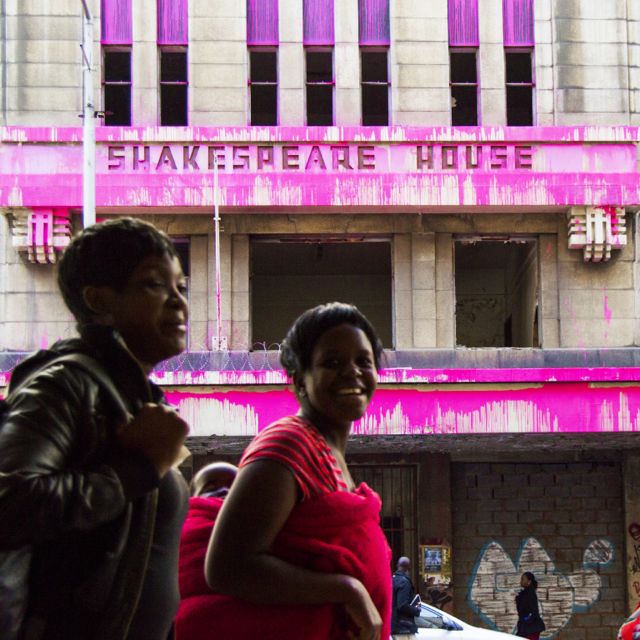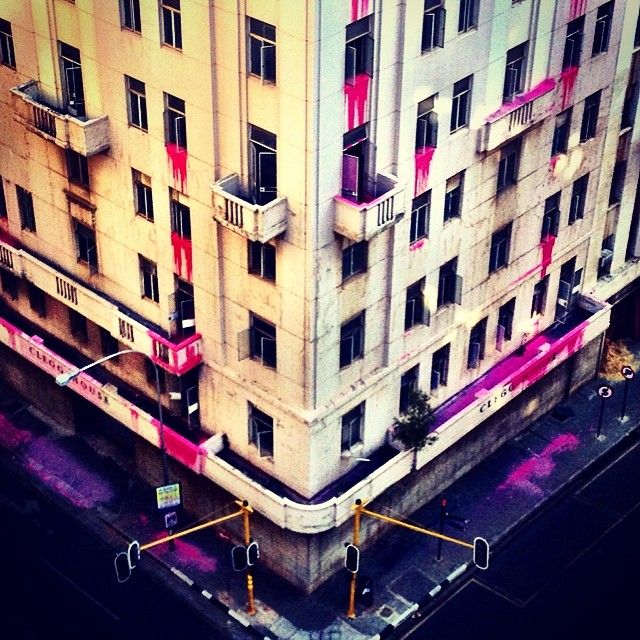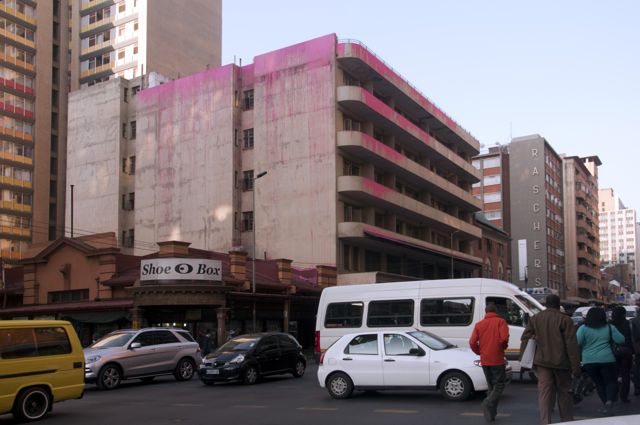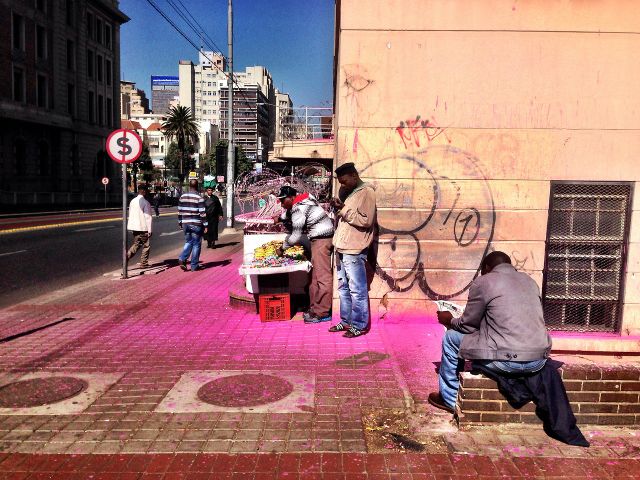
I land in Johannesburg for the third time in four years. I drive into the city guided by faint memory and intuition. I drive carefully but still I end up taking a wrong turn and land in the middle of town, on Main Street. Two things then seem clear: The first – there aren’t any white people on the streets. However, this is inaccurate; I look harder and find a single, tall white man exiting a mechanic’s shop. He has dropped off his Audi and is walking across the street towards a coffee shop. Though the abolishment of apartheid happened 20 years ago, downtown Johannesburg’s colour palette has changed, but not in the way one would have predicted.
The second: There is a plethora of big, fat, abandoned buildings, ten stories and higher, each of them marked by broken windows, barred doors, and bricked up floors. They are beautiful, hallowed objects left behind by time and a history long forgotten. From art deco to modernist and post-modernist architectural treasures, they are spread out sporadically from block to block, colour-less. Witnessing these human structures, one is reminded of post-apocalyptic, dystopian worlds popular in science fiction films and literature. Yet this is our world today, one in which thousands of people, most of them black citizens from all over Africa, live on the streets surrounded by squalor, in a city famous for its gold and diamond trade. Many of these individuals who migrate south hope to escape the hostility of war torn countries and encounter instead, a different type of war zone in Johannesburg.
Fascinated by how the city seems to have abandoned these buildings just like it has some of its population, I can not imagine that, almost six weeks later, I would find myself transported from the roof of one of these dilapidated buildings to a jail cell in Johannesburg’s central police station. The jail cell – with its many barred, fenced, and frosted glass windows–made me feel helpless. By contrast, the abandoned buildings – where most windows are broken or missing altogether-made my team and I feel an empowerment and awareness that vibrated with possibility.
Consider windowless buildings. Bleeding and gutted buildings. Consider a system in which government and privately owned buildings are left uncared for from block to block throughout the heart of a city. If the broken windows theory prescribes a zero tolerance policy for even minor damage to property, how can entire structures be abandoned, left to rot, without devastating effects on those who can not afford to move to other neighborhoods?
It was back in 1982 that the broken window theory was first introduced by social scientists Wilson & Kelling. They asked their audience to consider a building with a few broken windows. If the windows were not repaired, vandals would likely break a few more windows. Eventually, they may even break into the building, and – if it was unoccupied – perhaps become squatters or light fires inside.
Chapter two, section 26 of the Constitution of South Africa states that “Everyone has the right to have access to adequate housing.” With so many evictions happening due to Mayor Park Tau’s “Operation Clean Sweep” and with thousands of people in the inner city with no place to live, how can we go on ignoring all of these buildings that could be renovated as potential homes? “Demolition by decay” – as it is referred to in the blogosphere – still plagues the city centre today. The wickedness of some owners is only matched by the sheer indifference of the municipality, taking no action, even when owed millions of rand in rates.
The project
As I keep thinking of these still beautiful buildings, I speak to friends of mine, local artists, about turning them into “Living Sculptures” so that the people of Johannesburg are reminded of their presence and the injustice they embody.Maybe we could highlight the buildings? Maybe we could paint them hot-pink? From what I had observed in Jozi’s urban environment, there is not much of that colour anywhere… no South African brands seemed to use this colour and therefore it would be easy to create new associations in Johannesburg’s cultural landscape. The artists, and most people who learned about the project in the following weeks, were excited about the idea and “valued the style, urgency, underground stealth, surprise approach and the overall intention” of the project.
It is not until later, amongst painters, photographers, and print-makers that we decide on the style of painting: we will pour the paint from the top of the chosen dilapidated building first. Then we will go down floor by floor and collectively decide which windows will “bleed out.” We are excited by the notion that the buildings would appear to be crying, bleeding, leaking colour. The colour and medium of choice will take the form of more than 1000 litres of hot-pink, water-soluble paint.
Once the idea is solidified, we spread the word over a period of three weeks. More than thirty local creative agents of all colours and creeds join our nightly excursions to help paint and document our process. Friends invite friends. All show up after midnight wearing their old clothes, their curiosity, and their courage. We start in the last week of June and finish in the first week of August.

We study the buildings during the daytime: we draw up floor plans, circulation patterns, and check the finishes on floors and walls – mostly scattered debris. Then, at the agreed-upon early morning hour, we gather and travel downtown with our buckets of paint and our ladders. The big challenge with most of our buildings is gaining entry to the second floor – once inside, we usually have access to the rest of the building. We walk up to the roof, and prepare our tools, pouring the pink paint slowly and evenly from top to bottom. As much work as could be done in preparation, we never have control over how the paint will actually adhere to each building. The speed and texture always varies, and it is always exciting to gaze upon the end result the following morning.

It is not until we have found a comfortable pattern, meeting and working together while most of the city is asleep, that the head of security of our seventh highlighted building approaches us and calls the police. He wants to know what we are doing and why were doing it. From our pink stained attire, everyone could easily assume that we are responsible for the buildings that have been dressed in pink in the previous weeks.
As the leader of this project, I feel it is my duty to take care of whatever charges may come up and asked my fellow artists and activists to leave the scene. The police ask me to follow them to the station, along with the security guard, to talk to the colonel. Once there, I realise that I have no phone, no identification, and no way out.
At first, he claims that he could not let me go because I have no way to identify myself. Sometime after three in the morning they find a case number for a “malicious destruction of property” that had been pressed the previous week for one of our transformed buildings. With the case in hand, I am booked into Johannesburg’s central police station as a suspect. Feeling completely isolated and alone, one question comes to my mind: “what is more unjust: to allow buildings to decay and create an atmosphere that permeates of fear, or to use colour to create a conversation about how we can all be a part of bringing said buildings back to life?” And also, aren’t these buildings, a vital part of the fabric of the city of Johannesburg, all of our responsibility?
There are no white people to be found in the police station either. Again, this is inaccurate, as the colonel who deals with my case, pale and blonde haired, does so in a heavy Afrikaans accent. Everyone else in the prison, from the guards to the captives, range in colour from dark-chocolate to dark-caramel. My own colouring, pale-olive by comparison, is so striking to the rest of the population that, in the morning, one of the janitors come into my cell and inquire about why I am there. He claims that I look “out of place.” Even earlier, when I was being admitted, the constable looked up from her form and asked me if I was Black, Coloured, Indian/Asian or White. I looked back at her responding that I am not any of those things. “I am Latin American, Hispanic.” Looking back down and speaking sharply she responded, “We can just say you are White.”
Some parts of the prison feel as neglected and dilapidated as the buildings that I have been studying for weeks. Buildings like the CNA, Shakespeare House and New Kempsey – a full city block of historical Art Deco buildings, bricked up and left to crumble as rain pelts through the broken windows – are not that different from this local police station, and its inhabitants are often the very same hopeless people who sit and walk around the city’s Central Business District.
Painting is a way for us to challenge our colour-blindness to these issues. By highlighting these facades in pink, we have generated important dialogue and debate among the denizens of Johannesburg. We hope that these conversations will in turn, be a call to action. The project we started is ongoing and more buildings will be painted soon. Just like some of the legacy of apartheid, these buildings may be abandoned, but they are still standing. Now more than ever we are responsible for being aware of colour – whether it be in the black and white of race, or the pink of social injustice.

